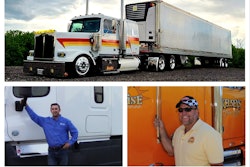Cost of ‘Cost Controls’
NASCAR’s effort to make the sport more affordable is actually hurting smaller teams
A few weeks ago, I flipped on the TV to watch qualifying for the Formula 1 Spanish Grand Prix and the announcers spent the entire first broadcast segment detailing all the technical advances the teams had made in the three weeks since the previous race. The list was amazing. Various teams had updated and improved everything from their front wings to their rear exhaust ducts.
NASCAR, I hope you were watching, too, because you need to let your Sprint Cup teams do the same.
The No. 82 Red Bull Toyota and its driver, Scott Speed.Way back when I started following NASCAR, the teams regularly came up with little tweaks and sometimes even big fixes that gave them an advantage — until everybody else caught on and caught up. I thought Ray Evernham was the best crew chief I’d ever seen because it seemed like he and Jeff Gordon were so often one step ahead of the competition.
As long as their inventions and advancements fit the templates and the cars passed inspection, Evernham and his fellow crew chiefs were free to innovate their brains out. And when they came up with something a little too radical, NASCAR would whack them and even put the rejected parts on display for all to see.

In recent years, however, NASCAR has eliminated almost all of this creativity in the name of cost control. Nowadays, Sprint Cup teams have very little latitude to improve their cars, especially once the season begins. Heck, all the bodies are the same now, and the extreme limitations on in-season testing mean the teams can’t even really practice outside of race weekends.
This is just wrong.
Innovation is the fuel of racing, and the fuel of innovation is trial and error. Without the ability to really tinker and test and try things out, even the greatest automotive designers and builders can only do so much.
NASCAR thinks it’s helping its Sprint Cup teams by forcing “cost controls” on them, but the reality is it’s only hurting the sport. Before NASCAR implemented its various cost-cutting measures a few years ago, the dominant teams were Hendrick Motorsports, Joe Gibbs Racing and Roush Fenway Racing. And now, with cost control in full effect? The same teams dominate, and the same mid-pack teams and bottom feeders struggle along.
I feel for those teams trying to keep up with the big behemoths. I’d hate to see Sprint Cup lose Robby Gordon or the Wood Brothers or Richard Petty Motorsports. But I firmly believe that the best chance they have to compete with Roush and Gibbs and Hendrick is to out-innovate them.
It can be done, and F1 teams prove it. For years, Honda spent hundreds of millions of dollars each season (the average F1 budget is around $150 million per car versus around $20 million per Sprint Cup car) for very little in the way of results. Frustrated and defeated, Honda closed shop at the end of 2008.
A few months before the start of the 2009 season, Honda sold its leftover bits and pieces to the newly formed Braun Racing team, which then tweaked the old cars, bought some Mercedes-Benz engines and went out and won the 2009 championship!
Freed from the Honda bureaucracy, Braun succeeded through creativity and guile, and in a short period of time found enough of a mechanical and aerodynamic advantage that allowed the team to dominate the early part of the season. Its competitors watched, learned and steadily crept up on Braun as the season wore on.
But in the end, Braun prevailed over the likes of Ferrari, Mercedes and Toyota and their oversize budgets. And so far this year another upstart team, Red Bull Racing, has come up with enough magic to build a decent points lead over the big boys.
The success of Braun and Red Bull should show NASCAR’s smaller teams that they need to push for more opportunities to innovate. They might be saving some money under the current scenario, but they’ve also surrendered any chance of achieving the kind of breakthrough that might help them upend the status quo.
So to NASCAR, I say set the Cup teams free. I grudgingly agree with the rule that limits each organization to four cars, but beyond that there should be no real financial restrictions. And, more importantly, NASCAR needs to forget the crazy idea that all the cars should look and run exactly the same — instead, they should reinstate the “gray areas” in the specs and templates that give the individual cars some personality and allow for true innovation.
As America’s biggest and most popular racing series, the Sprint Cup Series should be the best it can be. No limits on the opportunities for good ol’ all-American ingenuity would mean no limits on how great the racing can ultimately be.
LOOSE LUGNUTS
Road repairs Hey, somebody down there was listening! A few days after I wrote that Daytona International Speedway needed to be completely repaved, NASCAR announced that the entire speedway indeed will be repaved for only the second time in its history. As I’m sure you remember, a two-foot-wide pothole forced two delays totaling more than two hours during this year’s Daytona 500, effectively ruining what was otherwise a pretty entertaining race and embarrassing NASCAR on its most important day of the year.
Speedway officials had been planning only to install a concrete patch in the area surrounding the pothole, but eventually made the correct decision to repave the whole thing — racing surface, apron, skid pads, even pit road. The $20 million project will begin right after the Coke Zero 400 at Daytona on July 3, and is expected to wrap up around the end of the year.
Thumbs up Because so many controls on a Formula 1 car are embedded in the steering wheel, the drivers use their thumbs constantly during a race to do everything from adjusting the fuel mixture to changing brake bias from corner to corner. Ferrari driver Fernando Alonso has insured his thumbs for a cool $13 million. That sounds like a lot, until you realize that his salary for 2010 alone is $15 million.
“Apart from being essential when driving a Formula 1 car, [Alonso’s thumbs] represent a sign of victory and that everything is under control,” a Ferrari spokesman said when the policy was announced.
Hail to the chiefs Though they won’t make nearly as much cash as Alonso, Hendrick Motorsports crew chiefs Chad Knaus and Alan Gustafson have signed contract extensions that’ll keep them in place well into the future. Gustafson, who signed through 2014, is now working with Mark Martin and likely will be paired with Kasey Kahne when he comes over to Hendrick and slides into the No. 5. Knaus, of course, has won four straight Sprint Cup titles with Jimmie Johnson and signed through 2015, which is also when Johnson’s current contract expires.
Locking up Knaus is an especially good move by arguably the smartest organization in NASCAR. For my money, he’s the best all-around crew chief on pit road these days and worth every dollar he can get.
Kay Bell is an Austin, Texas-based writer. When she’s not yelling at her television during NASCAR races, she blogs about taxes and other financial topics at www.dontmesswithtaxes.typepad.com.









